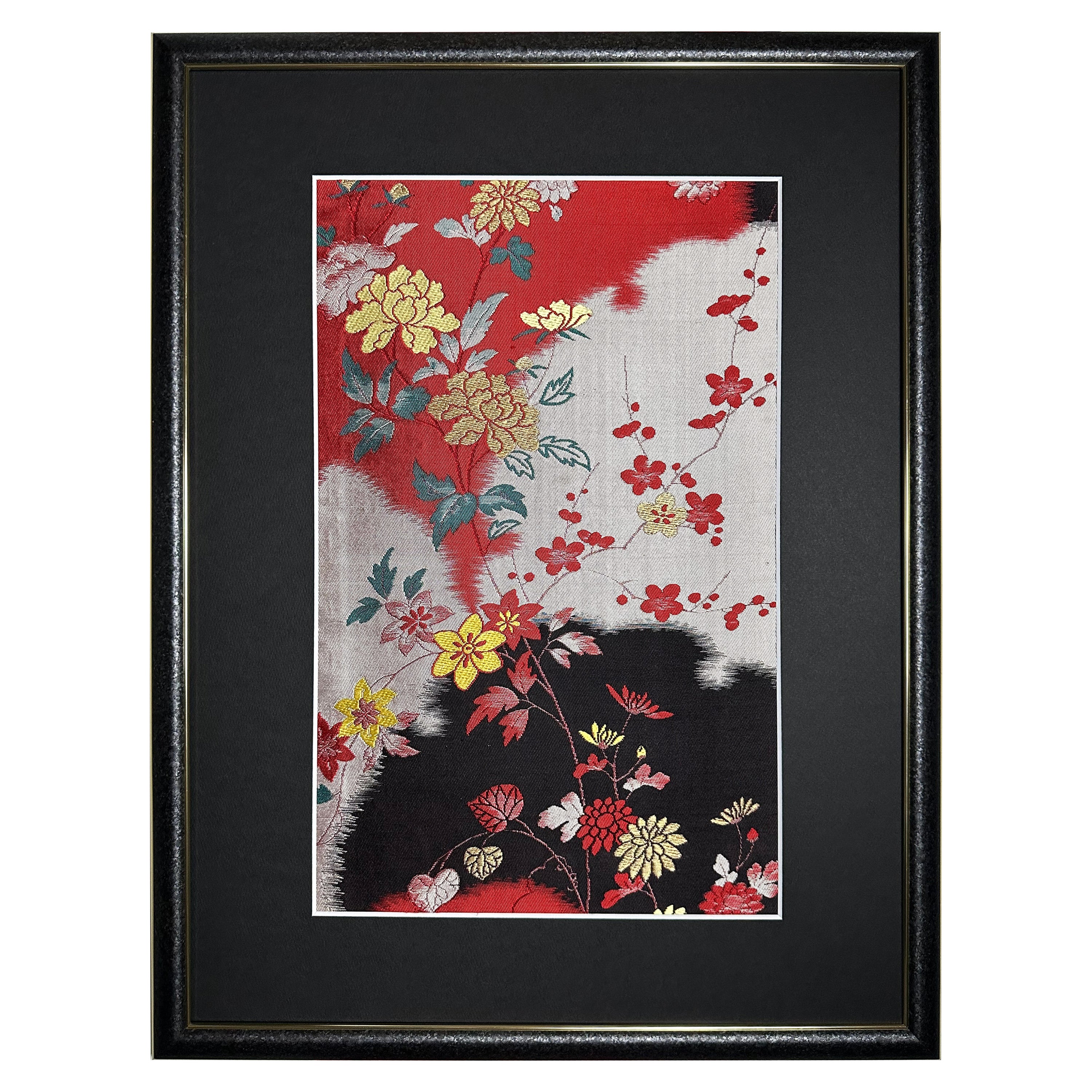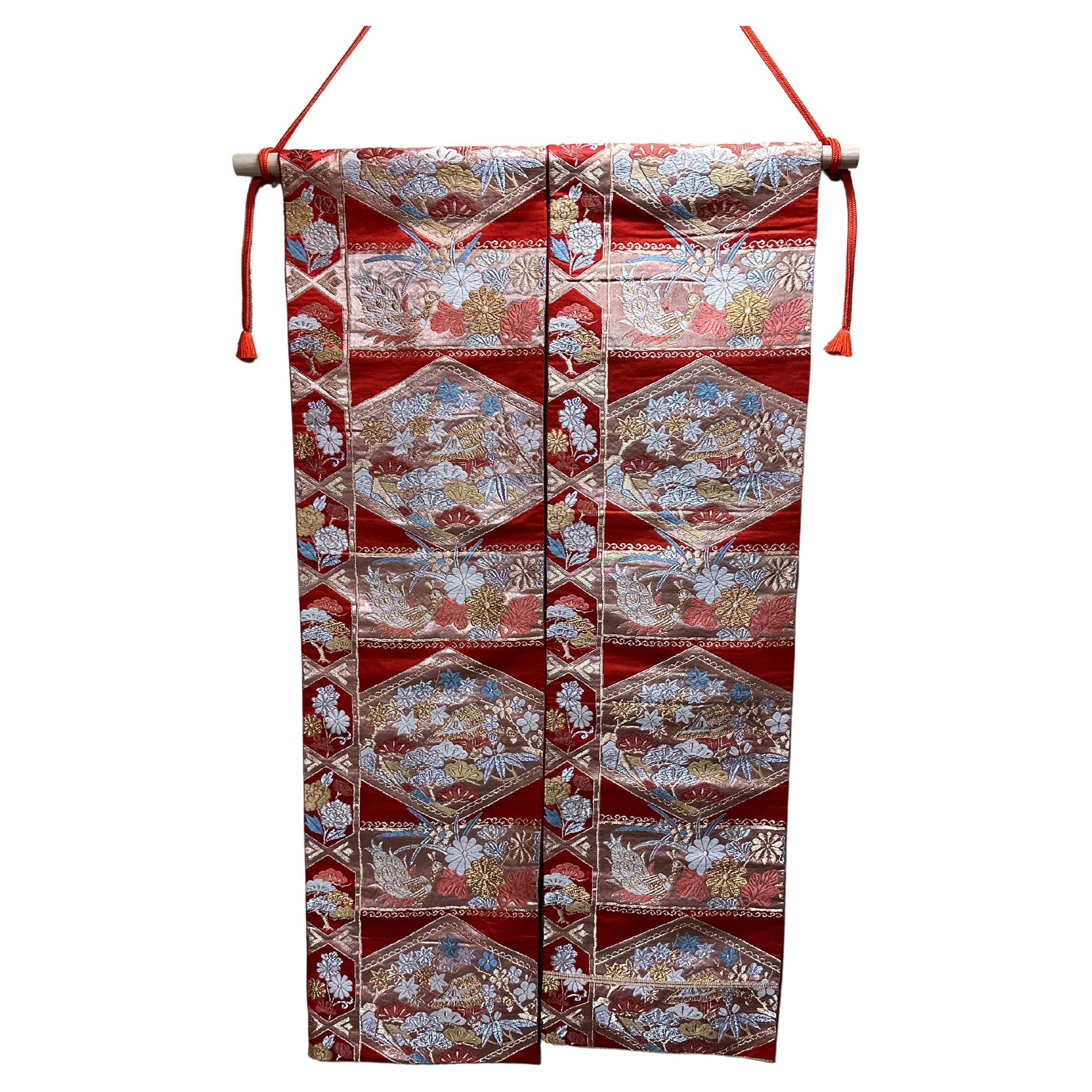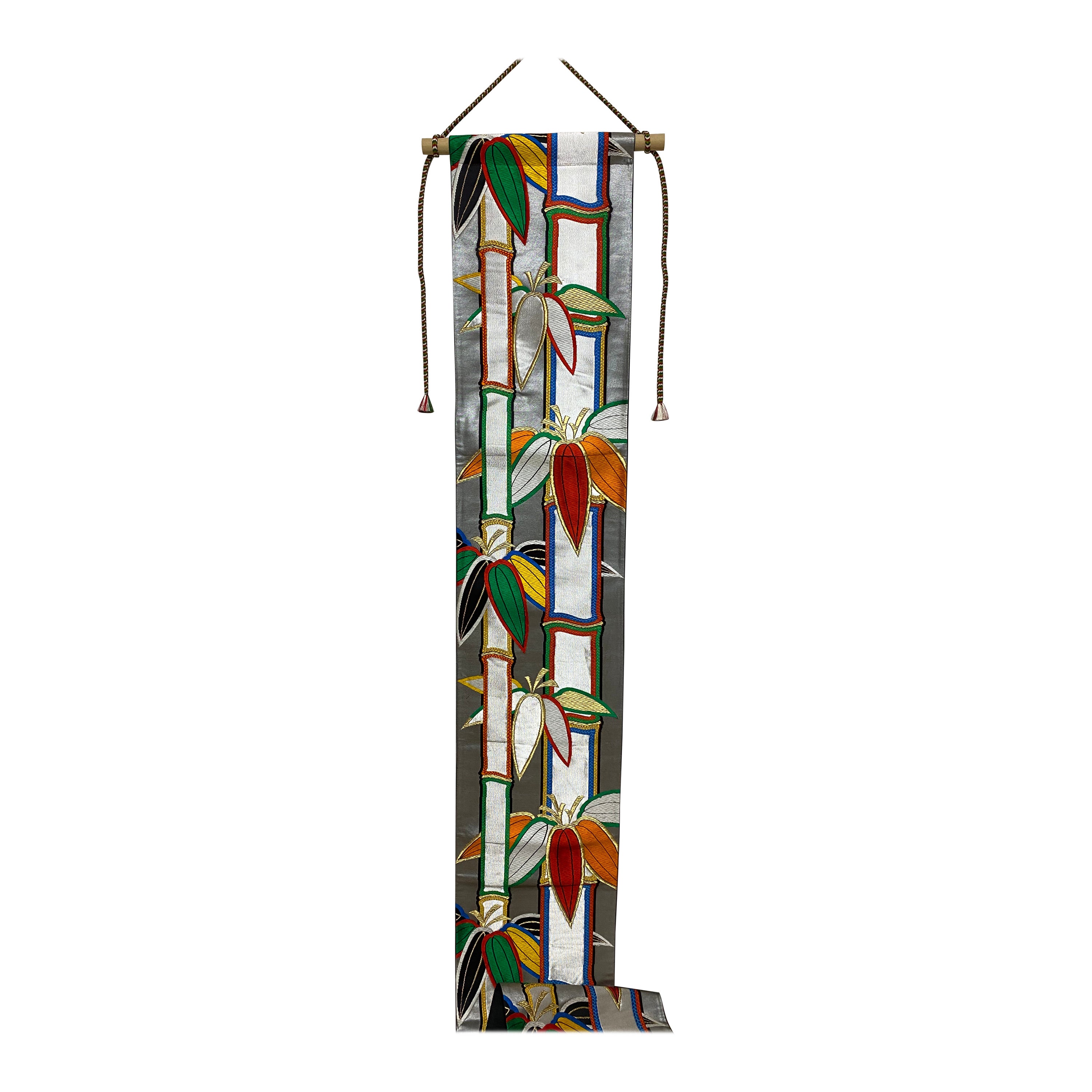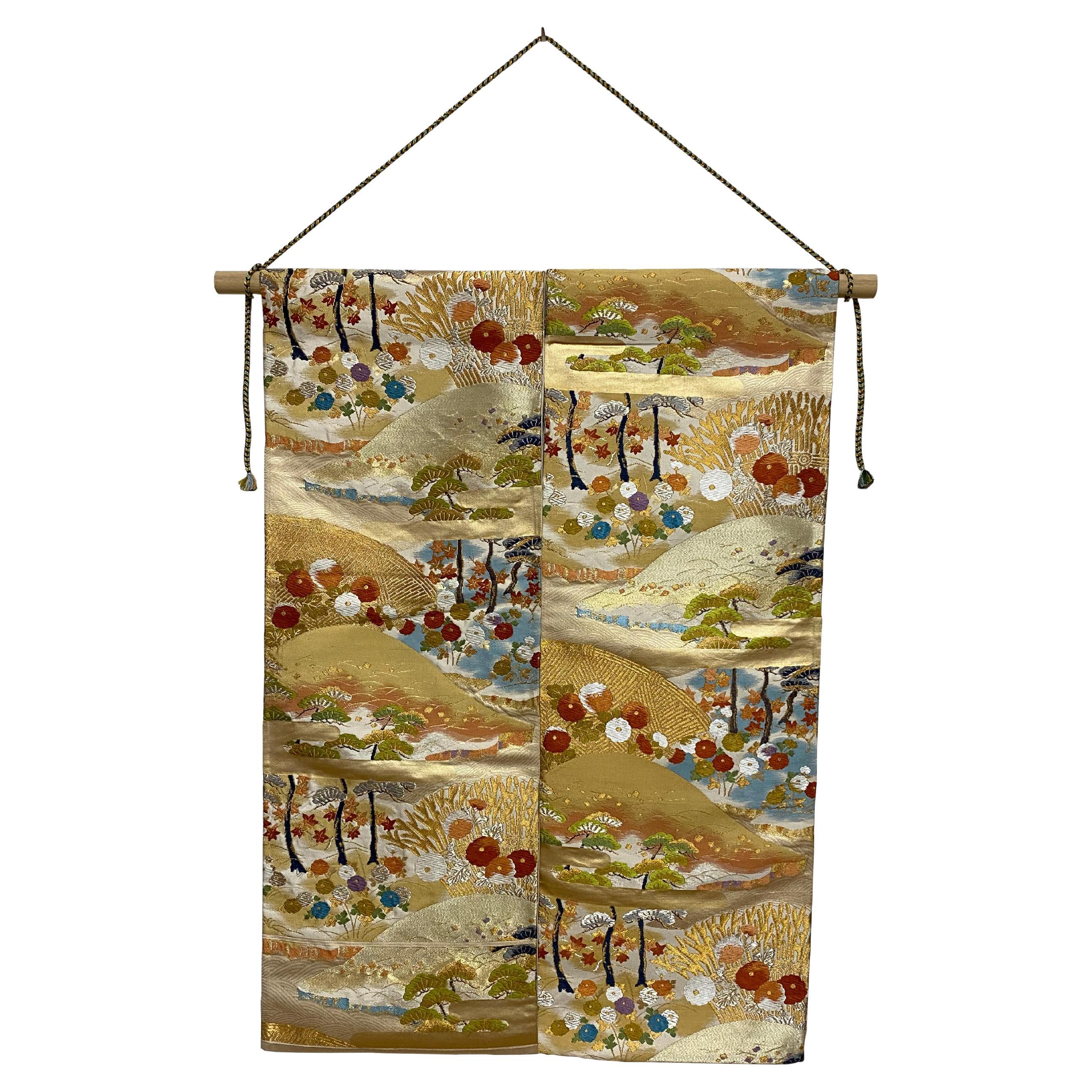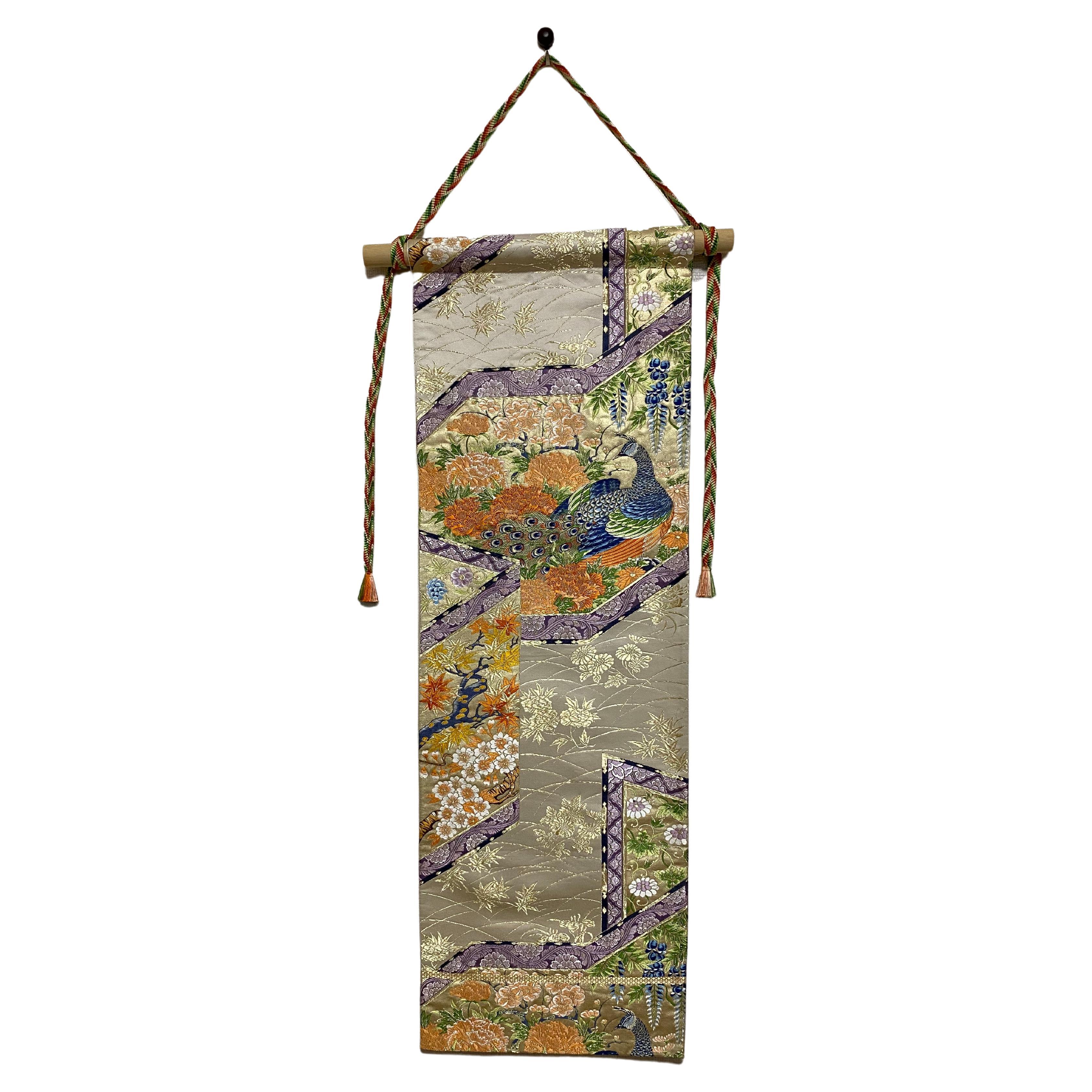Items Similar to "Seasonal Blessings" by Kimono-Couture, Japanese Art / Kimono Tapestry
Want more images or videos?
Request additional images or videos from the seller
1 of 8
"Seasonal Blessings" by Kimono-Couture, Japanese Art / Kimono Tapestry
About the Item
Kimono Tapestry "Seasonal Blessings" by Kimono-Couture
・Japanese Kimono Tapestry
・Textile Art
・Japanese Hanging Scroll
【Description of Kimono Art by Kimono-Couture】
Kimono Art is a form of Japanese Art that utilizes the highest quality vintage kimono obi, meticulously crafted by Kimono-Couture artisans.
Japanese obi, traditional crafts that embody advanced skills and deep dedication, are painstakingly produced through numerous intricate steps. The colors and patterns of these obi hold various wishes and meanings. However, as Western culture has become predominant, the kimono culture has declined, and today, opportunities to appreciate its beauty are limited to special events like weddings and graduations.
Therefore, Kimono-Couture takes on the challenge of reviving these obi as works of Framed Wall Art & Kimono Tapestry. Kimono-Couture skilled artisans are responsible for every aspect of the process, from sourcing the obi to the completion of Kimono Art, enhancing the beauty of these obi to the fullest.
In the following, we will explain the wishes and meanings woven into this Kimono Art.
【Description of this Kimono Art "Season Blessings"】
Kimono-Couture is delighted to introduce our exquisite Japanese Kimono Tapestry, entitled "Seasonal Blessings." This stunning piece of textile art is characterized by a base of rich red, black, and white silk, meticulously adorned with seasonal blossoms such as plum blossoms, peonies, chrysanthemums, and hollyhocks.
The smooth lines of red, black, and white elegantly convey feelings of kindness and respect. In the world of kimonos, each color holds deep symbolism. Red signifies "vitality" and "passion," often carrying wishes for warding off misfortune. Black, a color of great prestige, has long been an aspirational choice in the world of kimonos. White, on the other hand, is often used in joyous ceremonies like weddings and is considered an auspicious color.
The warm and gentle ambiance woven by the harmonious blend of red, black, and white is a distinctive hallmark of this Kimono Tapestry. We highly recommend adorning spaces such as your study, entrance, guest rooms, tea rooms, or hallways with "Seasonal Blessings." It encapsulates the essence of Japan, and its artisanal craftsmanship and heartfelt dedication are evident in every detail.
- Dimensions:Height: 38.59 in (98 cm)Width: 27.56 in (70 cm)Depth: 0.4 in (1 cm)
- Materials and Techniques:
- Place of Origin:
- Period:
- Date of Manufacture:2023
- Production Type:New & Custom(One of a Kind)
- Estimated Production Time:Available Now
- Condition:Additions or alterations made to the original: Kimono-Couture's masterful artisans breathe new life into vintage Japanese kimono obi, crafting exquisite Kimono Art. Their meticulous work spans from sourcing the obi to creating captivating pieces that accentuate the obi's intrinsic beauty.
- Seller Location:Shibuya City, JP
- Reference Number:1stDibs: LU8102237049122
Kimono-Couture
Japanese Kimono Art by Kimono-Couture Kimono-Couture proudly creates one-of-a-kind Kimono Art using the highest quality Japanese-made obi. Japanese obi are meticulously crafted through countless intricate processes. We firmly believe that obi represent the culmination of Japan's world-renowned craftsmanship. However, as the culture of wearing kimonos has declined, opportunities to appreciate their beauty have significantly diminished. Therefore, at Kimono-Couture, it is our mission to share the splendor of Japan's traditions, culture, and sensibilities and contribute to the world of kimono culture through the creation of Kimono Art. At Kimono-Couture, our skilled artisans painstakingly examine every detail of each obi to bring out its maximum charm, including patterns, colors, and dimensions. Kimono Art conveys various wishes and meanings through its patterns and colors. For instance, the peacock pattern symbolizes "compassion," "abundance," and "health," while the crane pattern represents "vitality" and "longevity." Detailed explanations of the themes and beliefs behind each piece are available in the description section of our works, which we invite you to explore. We take immense pride in delivering our Kimono Art and your satisfaction is our utmost priority. We offer the option of customizing from your preferred patterns and colors, and we are also happy to suggest recommendations based on the wishes and meanings of Kimono Art. Please don't hesitate to contact us!
You also can choose single tapestry ($730).
Our artisans at Kimono-Couture will do our best for your satisfaction.
Please feel free to reach out to us.
About the Seller
5.0
Vetted Seller
These experienced sellers undergo a comprehensive evaluation by our team of in-house experts.
Established in 2022
1stDibs seller since 2023
9 sales on 1stDibs
- ShippingRetrieving quote...Ships From: Tokyo, Japan
- Return PolicyA return for this item may be initiated within 7 days of delivery.
More From This SellerView All
- Framed Kimono Art "Seasonal Blessings" by Kimono-Couture, Japanese Textile ArtLocated in Shibuya City, TokyoJapanese Kimono Art "Prosperous Blossom" by Kimono-Couture ・Japanese Art ・Textile Art ・Framed Wall Art 【Description of Kimono Art by Kimono-Couture】 Kimono Art is a form of Japan...Category
21st Century and Contemporary Japanese Contemporary Art
MaterialsFabric, Acrylic, Yarn, Thread, Silk, Textile
- Kimono Art "Seasonal Blessings" by Kimono-Couture, Japanese Art, Framed Wall ArtLocated in Shibuya City, TokyoKimono Art "Seasonal Blessings" by Kimono-Couture ・Japanese Art ・Asian Wall Art ・Framed Wall Art 【Description of Kimono Art by Kimono-Couture】 Kimono Art is a form of Japanese Art...Category
21st Century and Contemporary Japanese Furniture
MaterialsFabric, Acrylic, Yarn, Thread, Silk, Textile
- Japanese Kimono Art / Tapestry, LongevityLocated in Shibuya City, TokyoThis orange silk-based obi is decorated with a tortoiseshell l pattern. The tortoiseshell pattern was handed down from China during the Asuka period in Japan. During the Heian period , only aristocrats were allowed to use the pattern, and the general public could not even see it. Therefore, the tortoiseshell pattern is known as a sacred and prestigious pattern. The tortoiseshell pattern is a regular hexagonal pattern, derived from the shell of a turtle. The regular hexagon is said to be the most stable shape in nature, which means ""sturdy and strong. Today, it is also said to be a pattern that brings good luck in money. The tortoiseshell pattern is decorated with pine trees, bamboo, plum blossoms, and flowers of the four seasons such as chrysanthemums, daffodils, autumn leaves, and peonies. In Japan, the pine, bamboo, and plum trees have been a traditional Japanese good-luck charm since around the Edo period Pine trees are as long as 200 to 400 years old, and some are thousands of years old. Pine trees grow in harsh environments where other trees cannot thrive, and they are considered a symbol of vitality and longevity because of their year-round blue foliage. Bamboo is a symbol of prosperity of offspring because it grows straight and straight with new shoots. Because of its nutritional value, the plum tree played the role of a medicine against illness in ancient Japan. When a Japanese emperor fell ill, he ate...Category
21st Century and Contemporary Japanese Tapestries
MaterialsSilk, Thread
- Japanese Tapestry / Kimono Art -Rainbow Bamboo-Located in Shibuya City, TokyoThis one-of-a-kind work of art, using a traditional kimono obi, is a masterpiece of Japanese craftsmanship. On a black silk ground and silver foil base, a gorgeous bamboo is embroidered by gold and silver threads and colorful silks such as red, yellow, orange, and green. Bamboo is a symbol of "healthy growth" and "steadfast loyalty" as it grows straight, strong, and spreads lush green leaves even in the cold of winter. As described in "Taketori-Monogatari" (the oldest story in Japan), it has been believed since ancient times that spiritual power resides in the joints and knots of bamboo. Thus, bamboo has been long cherished as a mysterious good-luck charm. This work evokes both the formidable power of bamboo and the elegance that overflows from the delicate use of color. In addition, although it is a traditional Japanese kimono obi...Category
21st Century and Contemporary Japanese Tapestries
MaterialsSilk, Thread
- Japanese Kimono Art / Kimono Tapestry / Hanging Scroll, Garden by the SeaLocated in Shibuya City, TokyoGarden by the Sea by Kimono-Couture *Japanese Kimono Art *Handmade by Kimono-Couture *One-of-a-kind Japanese Art This work is a tapestry of high quality kimono obi made by skilled ...Category
21st Century and Contemporary Japanese Tapestries
MaterialsGold Leaf
- Japanese Kimono Art / Kimono Tapestry, the King of PeacocksLocated in Shibuya City, TokyoThis Japanese kimono tapestry is the only one of its kind in the world. It has been carefully and meticulously embroidered by Japanese craftsmen. We are proud to present this Kimono tapestry, embroidered with peacocks and flowers of the four seasons on a silk fabric based on the traditional color called “Kinari.” The peacock symbolizes “compassion,” “fertility” and “good health.” Because its life force is so strong that it eats poisonous snakes and insects, the peacock is believed to ward off evil spirits and prevent against “misfortune” and “suffering.” Japan is famous for its drastically different seasons. As the colorful flowers bloom, we can sense that the seasons are changing. Each of the flowers on this piece are carefully chosen. Plum blossoms, wisteria, and cherry blossoms in the spring; iris and hollyhock blossoms in the summer; chrysanthemum blossoms and grapes in autumn; and peony blossoms in the winter. This is a wonderful Japanese tapestry...Category
21st Century and Contemporary Japanese Tapestries
MaterialsSilk
You May Also Like
- Old Japanese Kimono / 1912-1945 / Wall Hanging Decoration / TapestryLocated in Sammu-shi, ChibaI think this is a kimono woven from the Taisho era to the early Showa era (1912-1945) in Japan. It is a modern design. In the Taisho era, various things were made with reference to...Category
Early 20th Century Japanese Taisho Tapestries
MaterialsCotton
- Exceptional Embroidered Japanese Ceremonial KimonoLocated in Atlanta, GAA visually striking antique Uchikake Wedding Kimono/Robe for ceremonial occasion, circa end of Meiji to Taisho period 1910s-1930s. This bridal outer garment is of a bright red color ...Category
20th Century Japanese Japonisme Textiles
MaterialsBrocade, Silk
- Antique Japanese Embroidery TapestryLocated in Atlanta, GAA large Japanese silk embroidery tapestry circa 19th century, late Edo to early Meiji period. Meticulously handwork that densely depicts repea...Category
Antique 19th Century Japanese Japonisme Textiles
MaterialsSilk
- Exceptional Embroidered Vintage Japanese Ceremonial KimonoLocated in Atlanta, GAA visually striking vintage Uchikake Wedding Kimono/Robe for ceremonial occasion, circa 1930s-1950s in the Oriental Art Deco style. The bridal garment...Category
20th Century Japanese Japonisme Textiles
MaterialsCotton, Silk
- Vintage Japanese Formal Black Silk KimonoLocated in Atlanta, GAA vintage Japanese silk Kuro Tomesode Kimono, circa 1960s-1980s. Kuro Tomesode is a dress for married woman for the most formal occasions, equivalent of the evening gowns in the west...Category
Mid-20th Century Japanese Japonisme Textiles
MaterialsSilk
- Japanese Fisherman Festival Kimono with Tsutsugaki DesignLocated in Atlanta, GAA Japanese festival Kimono robe circa late 19th to early 20th century (end of Meiji Period) for fishing ritual. Made in a cotton fabric, the kimono was elaborately decorated by Tsuts...Category
Early 20th Century Japanese Meiji Textiles
MaterialsCotton, Linen
